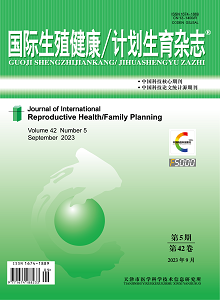Objective: To investigate the influencing factors of clinical pregnancy during the freeze-thawed embryo transfer (FET) cycle of hormone replacement therapy (HRT), and construct a clinical pregnancy prediction model. Methods: The clinical data of 2 107 cycles of the FET who underwent HRT at the Maternity Hospital of Nanjing Medical University from January 2018 to December 2020 were retrospectively analyzed. These cycles were randomly divided into the training set (1 499 cases) and the verification set (608 cases) according to the ratio of 7 ∶ 3. To explore the relationship between clinical characteristics and clinical pregnancy outcomes, they were divided into the clinical pregnancy group and the non-clinical pregnancy group. The least absolute shrinkage and selection operator (LASSO) regression model was used to screen the influencing factors, and the optimum parameter λ in the model was selected by the ten-fold cross-validation method. Multivariate Logistic regression analysis was used to construct a nomogram prediction model. The calibration curve, receiver operating characteristic (ROC) curve and decision curve analysis (DCA) were used to evaluate its effectiveness. Results: ① A total of 1 354 clinical pregnancy was in 2 107 cycles (64.26%). ②Ten variables selected by the LASSO regression model were included in the model, including age, basal FSH, basal LH, basal AMH, E2 at 14 days after FET, and the number of pregnancy, abortion, labor, induced abortion, and term birth. ③After adjusting for confounding factors, the multivariate Logistic regression analysis found that age, basal LH and AMH levels, and E2 levels at 14 days after FET were correlated with clinical pregnancy (both P<0.05), and a nomogram model was constructed accordingly. ④The areas under the ROC curve of the training set and the verification set were 0.662 and 0.683, respectively. The calibration curve showed a good consistency between the predicted risks and the actual results of the training set and the verification set, suggesting a certain degree of differentiation and good calibration degree. The DCA showed that when the threshold probabilities of the training set and the validation set were 1%-79% and 1%-81% respectively, the net benefit of patients was improved by using the column-line prediction model. Conclusions: A nomogram model was established to predict clinical pregnancy in the patients with FET, which can help clinicians to take the personalized treatment measure during or before FET so as to improve the clinical pregnancy rate to a certain extent.

